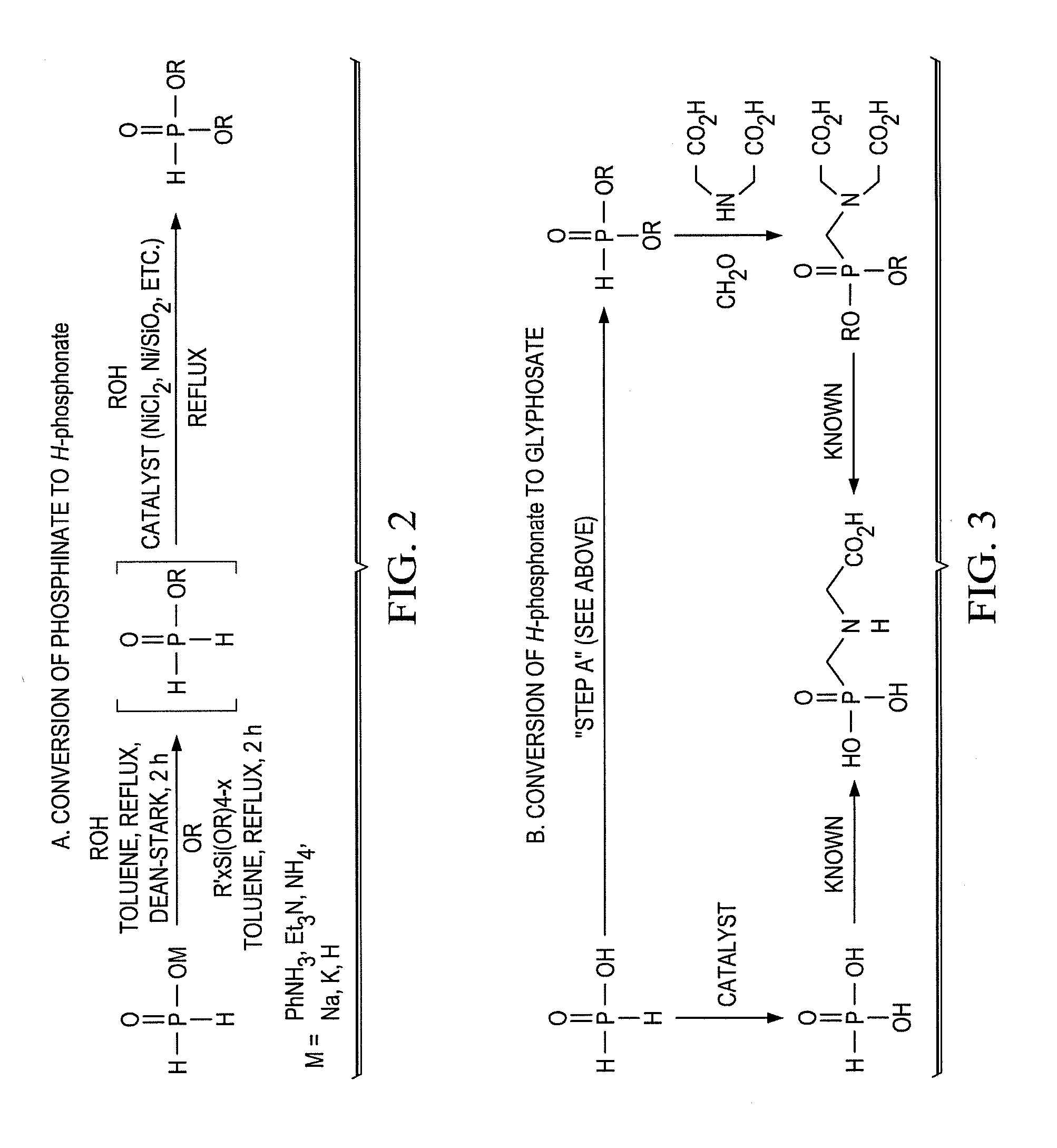Synthesis of H-phosphonate intermediates and their use in preparing the herbicide glyphosate
a technology of hphosphonate and intermediates, which is applied in the field of synthesis of hphosphonate intermediates and their use in the preparation of herbicides, can solve the problems of high reactive compound, inability to sustain food production for the planet's population, and inability to meet the needs of the population,
- Summary
- Abstract
- Description
- Claims
- Application Information
AI Technical Summary
Benefits of technology
Problems solved by technology
Method used
Image
Examples
example 1
Preparation of Alkyl H-Phosphonates by Dean-Stark Esterification Followed by Metal-Catalyzed Oxidation
[0025]Aqueous hypophosphorous acid (50 wt. %, 10 mmol) was weighed into a round bottom flask and concentrated under reduced pressure for 15 minutes at room temperature. Butanol (30 mmol) and toluene (to 0.5 M) were added to the reaction vessel, and the solution was heated to reflux for 2 hours under nitrogen atmosphere. During this period, water was collected in a Dean-Stark trap filled with excess toluene. 31P-NMR analysis of the cooled solution showed near quantitative formation of butyl phosphinate. The Dean-Stark trap was removed and Ni / SiO2 (65 wt. %, 0.5 mmol) was added. The mixture was refluxed at good agitation for a period of 16 to 18 hours. 31P-NMR analysis of the formed H-phosphonate showed >90% purity.
example 2
Preparation of Alkyl H-Phosphonate Using Alkoxysilane Esterification Followed by Metal-Catalyzed Oxidation
[0026]Aqueous hypophosphorous acid (50 wt. %, 10 mmol) was concentrated under reduced pressure for 15 minutes at room temperature. Dimethyldiethoxysilane (20 mmol) and toluene (up to 0.5M) was added to the reaction vessel, and the solution was heated to reflux for 2 hours under nitrogen atmosphere. NMR analysis showed quantitative formation of ethyl phosphinate. After cooling, ethanol (30 mmol) and Ni / SiO2 (65 wt. %, 0.5 mmol) was added, and the mixture was refluxed for 30 hours. 31P-NMR analysis showed >90% purity of the formed H-phosphonate.
example 3
Preparation of Glyphosate Using Alkyl-H-Phosphonate
[0027]Methanol was added to iminodiacetic acid (15 mmol), paraformaldehyde (23 mmol) and triethylamine (30 mmol). The mixture was refluxed for 2 hours, and upon completion was cooled and concentrated under reduced pressure to remove the excess methanol and triethylamine. Crude H-phosphonate solution as prepared in either Example 1 or Example 2 was added to imine intermediate, and refluxed for another 2 hours. 31P-NMR analysis showed >90% completion of the reaction. The solution was extracted with 1M hydrochloric acid solution to remove triethylamine and form the free acid. The organic layer was dried with anhydrous magnesium sulfate, filtered over celite to remove any residual Ni / SiO2 catalyst, and concentrated under reduced pressure. Water (10 mL) and concentrated sulfuric acid (10 to 20 mmol) was added to the crude dialkyl N-(phosphonomethyl)diacetic acid and the solution was heated to 85° C. Hydrogen peroxide (30 wt. %, 10 mL) wa...
PUM
| Property | Measurement | Unit |
|---|---|---|
| wt. % | aaaaa | aaaaa |
| time | aaaaa | aaaaa |
| energy efficient | aaaaa | aaaaa |
Abstract
Description
Claims
Application Information
 Login to View More
Login to View More - R&D
- Intellectual Property
- Life Sciences
- Materials
- Tech Scout
- Unparalleled Data Quality
- Higher Quality Content
- 60% Fewer Hallucinations
Browse by: Latest US Patents, China's latest patents, Technical Efficacy Thesaurus, Application Domain, Technology Topic, Popular Technical Reports.
© 2025 PatSnap. All rights reserved.Legal|Privacy policy|Modern Slavery Act Transparency Statement|Sitemap|About US| Contact US: help@patsnap.com



